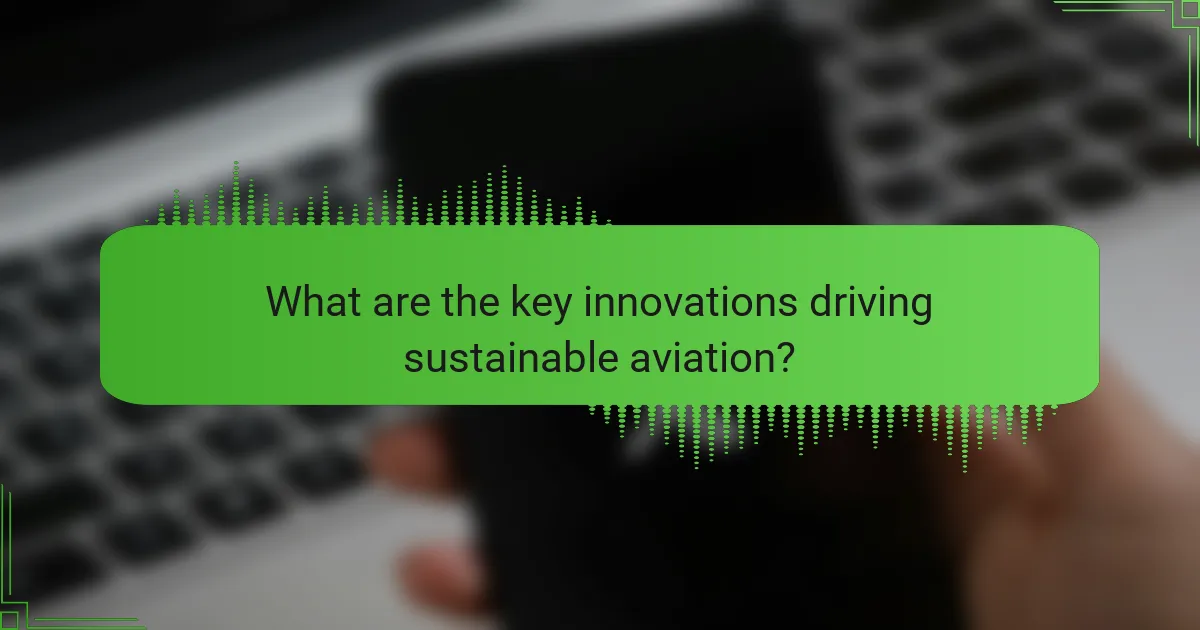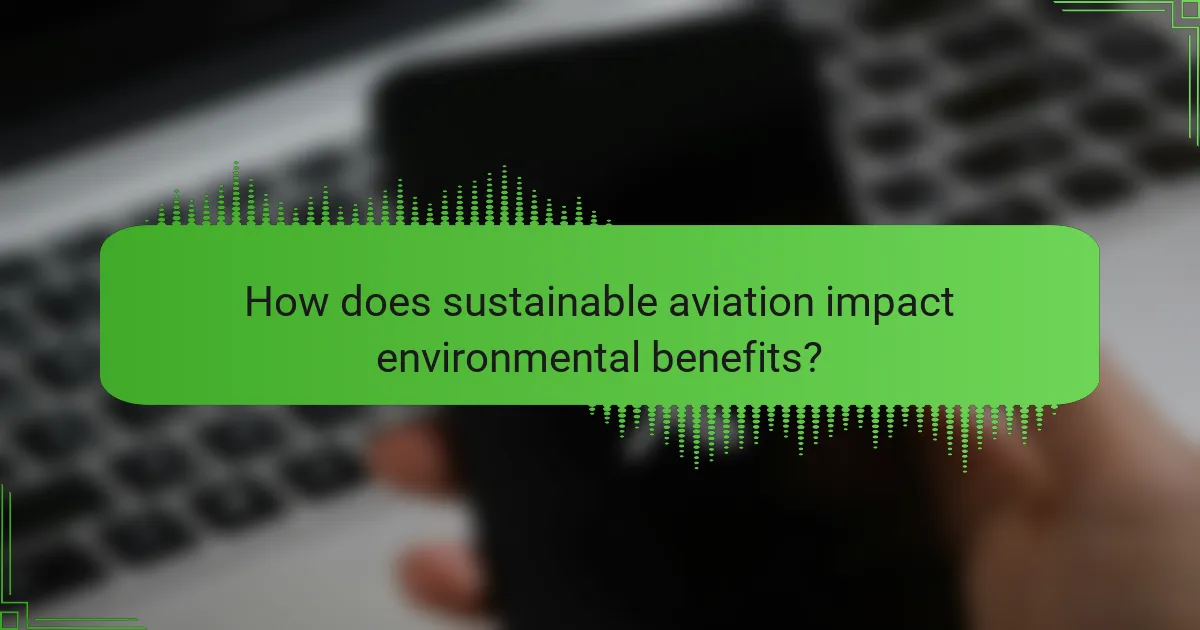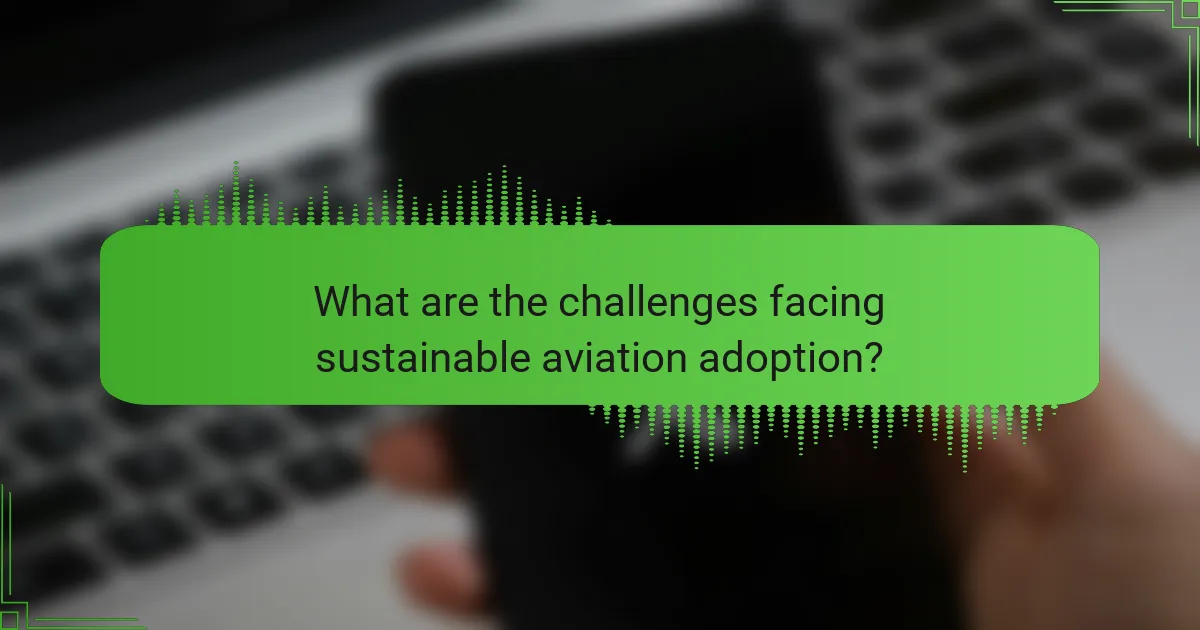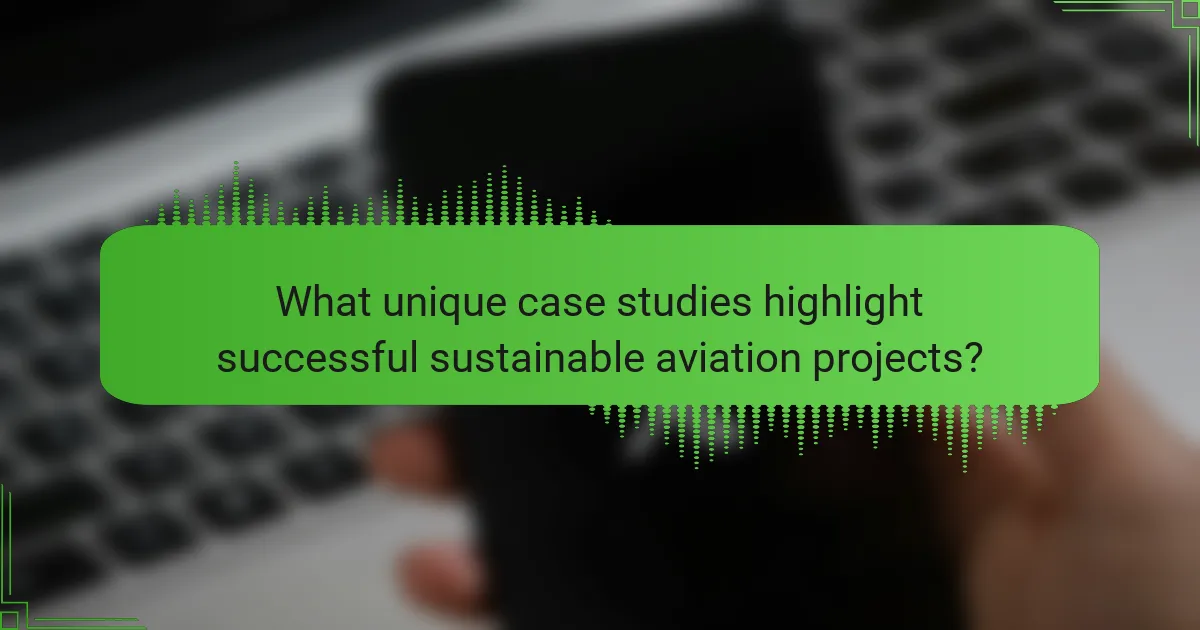Sustainable aviation offers significant environmental benefits by reducing greenhouse gas emissions and noise pollution. Key innovations include electric propulsion systems, advanced aerodynamics, and sustainable aviation fuels. Regulatory frameworks support these initiatives, while challenges like high costs and public perception persist. Successful case studies and emerging trends highlight the industry’s commitment to a greener future.

What are the key innovations driving sustainable aviation?
Key innovations driving sustainable aviation include electric propulsion systems, advanced aerodynamics, and sustainable aviation fuels. These technologies reduce emissions and enhance fuel efficiency. Electric propulsion systems, such as hybrid-electric engines, significantly lower carbon output. Advanced aerodynamics improve aircraft design, minimising drag and increasing efficiency. Sustainable aviation fuels, derived from renewable resources, can reduce lifecycle greenhouse gas emissions by up to 80%. These innovations collectively contribute to a more sustainable aviation industry, addressing environmental concerns while maintaining operational effectiveness.
How do electric and hybrid aircraft contribute to sustainability?
Electric and hybrid aircraft significantly enhance sustainability in aviation by reducing emissions and fuel consumption. These innovations leverage electric propulsion systems, which can lower carbon footprints compared to traditional jet engines. For example, electric aircraft can achieve up to 50% reduction in greenhouse gas emissions during flight. Hybrid models combine electric and conventional engines, offering flexibility and efficiency for various flight profiles. Additionally, advancements in battery technology are improving energy density, allowing longer ranges and more sustainable operations. As a result, these aircraft contribute to cleaner air and reduced noise pollution, promoting a greener future for the aviation industry.
What role do sustainable aviation fuels play in reducing emissions?
Sustainable aviation fuels significantly reduce emissions by replacing conventional fossil fuels. These fuels can lower lifecycle greenhouse gas emissions by up to 80% compared to traditional jet fuels. They are derived from renewable resources, such as plant oils and waste materials, which contribute to a circular economy. Additionally, sustainable aviation fuels can enhance energy efficiency and reduce particulate matter, improving air quality. As a result, their adoption is crucial for the aviation industry’s goal of achieving net-zero emissions by 2050.
Which technologies are enhancing fuel efficiency in modern aircraft?
Technologies enhancing fuel efficiency in modern aircraft include advanced aerodynamics, lightweight materials, and hybrid propulsion systems. These innovations reduce drag, lower weight, and optimise engine performance.
Advanced aerodynamics, such as winglets and streamlined designs, minimise drag and improve lift-to-drag ratios. Lightweight materials like carbon fibre composites significantly reduce aircraft weight, leading to lower fuel consumption. Hybrid propulsion systems combine traditional jet engines with electric power, further enhancing efficiency and reducing emissions.
Additionally, engine technologies like variable cycle engines adjust performance based on flight conditions, maximising efficiency across various phases of flight. These advancements collectively contribute to sustainable aviation by lowering carbon footprints and operational costs.

How does sustainable aviation impact environmental benefits?
Sustainable aviation significantly reduces environmental impacts by lowering greenhouse gas emissions and noise pollution. Innovations such as biofuels and electric propulsion contribute to these benefits. For example, sustainable aviation fuels can reduce carbon emissions by up to 80% compared to traditional jet fuels. Additionally, advancements in aerodynamics and lightweight materials enhance fuel efficiency, further decreasing environmental footprints. As a result, sustainable aviation represents a crucial step toward a greener future in air travel.
What are the potential reductions in greenhouse gas emissions?
Sustainable aviation innovations can significantly reduce greenhouse gas emissions by up to 80% compared to traditional aircraft. These reductions stem from advancements in fuel efficiency, alternative fuels, and electric propulsion systems. For instance, the use of sustainable aviation fuels can lower lifecycle emissions by 70%. Additionally, improved aerodynamics and lightweight materials contribute to enhanced efficiency. As a result, the aviation industry can make substantial progress toward climate goals.
How does sustainable aviation improve air quality?
Sustainable aviation significantly improves air quality by reducing greenhouse gas emissions and harmful pollutants. Innovations such as sustainable aviation fuels (SAFs) and advanced aircraft designs decrease particulate matter and nitrogen oxides. For instance, SAFs can reduce lifecycle carbon emissions by up to 80%. Furthermore, electric and hybrid propulsion systems are being developed, which promise zero emissions during flight. As a result, these advancements contribute to cleaner air and a healthier environment.
What are the long-term ecological impacts of sustainable aviation practices?
Sustainable aviation practices lead to significant long-term ecological impacts, including reduced greenhouse gas emissions, improved air quality, and enhanced biodiversity. The adoption of alternative fuels and innovative technologies minimises carbon footprints, contributing to climate change mitigation. As a result, ecosystems experience less disruption, fostering healthier wildlife populations. Moreover, sustainable practices promote responsible land use, preserving habitats that are crucial for various species.

Which regulatory frameworks support sustainable aviation initiatives?
Regulatory frameworks supporting sustainable aviation initiatives include international agreements and national policies. These frameworks aim to reduce emissions and promote environmentally friendly practices within the aviation sector. Key examples are the Carbon Offsetting and Reduction Scheme for International Aviation (CORSIA) and the European Union Emissions Trading System (EU ETS). These initiatives establish guidelines for carbon neutrality and incentivise the adoption of sustainable technologies. As a result, they facilitate innovation and environmental benefits in aviation, contributing to a greener future.
How do international agreements shape sustainable aviation policies?
International agreements significantly influence sustainable aviation policies by establishing regulatory frameworks and promoting collaboration. These agreements facilitate the adoption of innovative technologies and practices that reduce environmental impacts. For instance, the Carbon Offsetting and Reduction Scheme for International Aviation (CORSIA) aims to stabilise net carbon emissions from international flights. This initiative exemplifies how global cooperation can drive the aviation sector towards sustainability. Additionally, agreements often set targets for emissions reductions, incentivising airlines to invest in cleaner fuels and more efficient aircraft. Overall, international frameworks are crucial for aligning global aviation practices with environmental goals.
What role do local governments play in promoting sustainable aviation?
Local governments play a crucial role in promoting sustainable aviation through policy development, funding initiatives, and community engagement. They establish regulations that encourage the use of eco-friendly technologies and practices in airports and airlines. For example, many local governments invest in renewable energy sources to power airport operations, reducing carbon emissions. Additionally, they may provide incentives for airlines to adopt sustainable practices, such as using biofuels or investing in more efficient aircraft. By collaborating with stakeholders, including airlines and environmental organisations, local governments foster innovation and drive the transition to sustainable aviation practices.

What are the challenges facing sustainable aviation adoption?
Sustainable aviation adoption faces challenges such as high costs, technological limitations, regulatory hurdles, and public perception. These factors hinder the transition to greener alternatives.
High costs involve significant investment in new technologies and infrastructure. Technological limitations relate to the current efficiency of sustainable fuels and electric propulsion systems. Regulatory hurdles stem from the need for updated policies to support innovation. Public perception plays a role, as consumers may be hesitant to embrace new aviation technologies.
Addressing these challenges requires collaboration among stakeholders, investment in research, and effective communication to build trust in sustainable aviation solutions.
Which economic factors hinder the transition to sustainable aviation?
High costs and limited technology hinder the transition to sustainable aviation. Economic factors include the significant investment required for research and development, which restricts funding availability. Additionally, existing infrastructure and fuel supply chains are optimised for traditional fuels, complicating the shift to sustainable alternatives. Market demand for lower ticket prices further pressures airlines to prioritise short-term profits over sustainable practices. Lastly, regulatory frameworks often lag behind technological advancements, creating uncertainty for investors and industry stakeholders.
What technical obstacles must be overcome for widespread implementation?
Widespread implementation of sustainable aviation faces several technical obstacles. Key challenges include developing efficient energy sources, enhancing battery technology, and ensuring infrastructure compatibility.
1. Energy density: Current battery technology lacks the energy density required for long-haul flights.
2. Regulatory standards: New safety and environmental regulations must be established for alternative fuels.
3. Aircraft design: Existing aircraft may need significant redesign to accommodate new technologies.
4. Production scalability: Manufacturing processes for sustainable materials need to be optimised for large-scale production.
5. Infrastructure adaptation: Airports must upgrade facilities to support new aircraft and fueling systems.
6. Economic viability: High initial costs of sustainable technologies may deter investment and adoption.

What unique case studies highlight successful sustainable aviation projects?
Several unique case studies showcase successful sustainable aviation projects. One notable example is the ZeroAvia project, which developed a hydrogen fuel cell system for aircraft, aiming to reduce carbon emissions significantly. Another case is the Airbus E-Fan X, a hybrid-electric aircraft designed to demonstrate the potential of electric propulsion in aviation. Additionally, the United Airlines initiative to invest in sustainable aviation fuel (SAF) production highlights a commitment to reducing the carbon footprint of air travel. These projects illustrate innovative approaches to enhancing sustainability in aviation.
How did specific airlines implement sustainable practices effectively?
Airlines have effectively implemented sustainable practices through innovations in fuel efficiency, waste reduction, and carbon offsetting. For example, Delta Air Lines invested in more fuel-efficient aircraft, reducing emissions by 20% over the last decade. Similarly, Lufthansa introduced a comprehensive recycling program, diverting 90% of onboard waste from landfills. Additionally, United Airlines has committed to purchasing sustainable aviation fuel, aiming for 50% reduction in greenhouse gas emissions by 2050. These initiatives not only enhance operational efficiency but also contribute significantly to environmental sustainability in aviation.
What lessons can be learned from pioneering sustainable airports?
Pioneering sustainable airports offer valuable lessons in environmental responsibility and innovation. They demonstrate the importance of integrating renewable energy sources, such as solar and wind, into airport operations. These airports often utilise advanced waste management systems to minimise landfill contributions and promote recycling. Additionally, implementing green building practices enhances energy efficiency and reduces carbon footprints. Collaboration with local communities fosters sustainable development and supports regional economies. These strategies highlight the potential for airports to lead in environmental stewardship while maintaining operational efficiency.

What future trends are emerging in sustainable aviation?
Emerging trends in sustainable aviation focus on innovative technologies and practices that reduce environmental impact. Key developments include the use of sustainable aviation fuels (SAFs), which can decrease lifecycle carbon emissions by up to 80%. Electric and hybrid-electric aircraft are gaining traction, promising reduced noise and emissions. Advanced air mobility concepts, like urban air taxis, are being explored for efficient, low-emission transport. Additionally, improvements in aerodynamics and lightweight materials are enhancing fuel efficiency. As a result, the aviation industry is moving towards a more sustainable future.
Which innovations are expected to shape the next decade of sustainable aviation?
Innovations shaping sustainable aviation in the next decade include electric propulsion, sustainable aviation fuels, and advanced materials. Electric propulsion systems are expected to reduce emissions significantly. Sustainable aviation fuels, derived from renewable sources, can lower lifecycle carbon footprints. Advanced materials, such as lightweight composites, will enhance fuel efficiency and reduce operational costs. These innovations collectively aim to create a more environmentally friendly aviation industry.
How are consumer preferences influencing sustainable aviation developments?
Consumer preferences are significantly driving sustainable aviation developments. As awareness of environmental issues grows, passengers increasingly prioritise eco-friendly travel options. Airlines are responding by investing in cleaner technologies and sustainable fuels, aiming to reduce carbon emissions and enhance operational efficiency.
Recent studies indicate that 70% of travellers are willing to pay more for sustainable flight options. This shift in consumer behaviour is prompting innovations such as electric aircraft and improved fuel efficiency. For example, some airlines are exploring hybrid propulsion systems to minimise environmental impact.
Moreover, regulatory pressures are aligning with consumer demands, pushing the industry towards greater sustainability. Airlines that adopt eco-friendly practices can enhance their brand image and attract environmentally conscious customers. This alignment of consumer preferences and industry initiatives fosters a more sustainable aviation future.
What best practices should stakeholders adopt for successful implementation?
Stakeholders should adopt collaborative strategies, invest in research, and prioritise regulatory compliance for successful implementation. Engaging with diverse partners enhances innovation and resource sharing. Conducting thorough assessments of environmental impacts ensures sustainable practices. Regular training and awareness programs foster a culture of sustainability among employees. Establishing clear metrics for success allows for continuous improvement and accountability.


